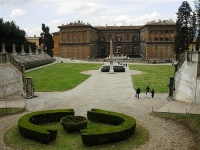
Originally owned by the wealthy banker Luca Pitti, the Palazzo later became the property of the Medici family and was the one-time residence of the Italian king. It is a grand structure that now boasts no less than seven museums. Among these are the Medici treasures that are showcased in the Museo degli Argenti, the Museum of Costumes and the Porcelain Museum. The Galleria d'Arte Moderna provides a fascinating display of works from the Macchiaioli school - early 19th-century proto-impressionist paintings - as well as a collection of Neoclassical and Romantic art. The collections in the Palazzo Pitti can keep visitors captivated for hours.Extending behind the palace are the elaborately landscaped and beautifully maintained Giardino Boboli (Boboli Gardens), one of the oldest gardens in Italy and well-known for its fountains and grottoes. The most celebrated aspect of the gardens is the Grotta del Buontalenti, located close to the entrance. In the deepest recess of the cave is the sculpture Venus Emerging from her Bath, attended by curious imps. Another notable structure is the enormous amphitheatre designed on a scale to serve the Medici's tastes.
Address : Piazza Pitti 1
Website : www.polomuseale.firenze.it/en/musei/pitti.php?m=palazzopitti
Telephone : +39 055 294 883
Opening times : Each museum has its own opening hours, but most are closed on Mondays
Admission : There are a variety of ticket options available. Check the website for further details.
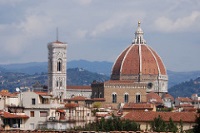
Santa Maria del Fiore, the Duomo or Cathedral of Florence, is set in the heart of the city and perches above the metropolis like an emperor before his subjects. Its most distinctive feature is the enormous dome, designed by Filippo Brunelleschi and built between 1420 and 1436. Visitors can climb between the two shells of the cupola for an unrivalled panorama of the city.The original Gothic exterior was destroyed in 1587 so that it could be replaced by the styling of the High Renaissance. However, this vision died prematurely with its patron, the Grand Duke Francesco de Medici, and the funding to build the neo-Gothic façade that we see today was not found until the 19th Century. The Campanile (bell tower) was built according to Giotto's designs in 1334, and is an elegant prop to Brunelleschi's stout Cathedral. The tower is decorated with two garlands of bas-reliefs, strung around its pink, white and green marble façade. Above, sculptures of the Prophets and Sybils, carved by Donatello, look down upon the city below.The Campanile can also be climbed for the magnificent views over the square and the adjacent cathedral. The neighbouring Baptistry, with its famous doors designed by Lorenzo Ghiberti, is one of Florence's oldest buildings and was originally a pagan temple. The gilded brass doors, dubbed the 'Gates of Paradise', were commissioned in 1401 to mark Florence's deliverance from the plague. The original panels are in the Museo dell'Opera del Duomo (the Duomo Works Museum), which exists largely to safeguard the sculptures removed from the doors and niches around the Piazza del Duomo. The museum also contains the machines used in the construction of the cathedral's dome, and has displays devoted to the problematic construction of the cathedral's façade. A room containing Ghiberti's baptistry doors provides an opportunity to closely examine the stiacciato relief technique used.Other noteworthy artefacts found in the museum include Michelangelo's Pieta, the carved figures of Donatello's Prophets as well as his Magdalene sculpture. In the anteroom are Andrea Pisano's panels from the first few levels of the bell tower.
Address : Piazza Duomo
Website : www.duomofirenze.it/index-eng.htm
Telephone : +39 0173 366167
Opening times : Cathedral open Monday to Saturday, from 10am to 5pm (Thursdays until 3:30pm; Saturdays until 4.45pm); and on Sundays from 1.30pm to 4.45pm. Museum open Monday to Saturday from 9am to 7.30pm, and on Sundays from 9am to 1.40pm
Admission : Cathedral entry is free, but there are admission fees for the baptistry, the dome, the cupola and museum.
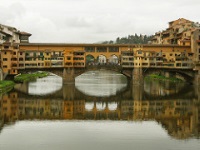
The Ponte Vecchio's status as the oldest bridge in Florence saved it from destruction during the Nazi retreat from Italy in 1944. They defied orders to blow up the stately bridge straddling the Arno River and bombed the ancient buildings on either side of it instead. The Arno Flood of 1966 also tested the bridge's resilience, and swept parts of it away in its powerful current. The most affected sections were the iconic overhanging shops belonging to the gold and silversmiths. In 1593 the original tenants - butchers, tanners and blacksmiths - were evicted from the workshops because of the noise and stench they created, to make way for more refined merchants and craftsmen. To one side of the bridge is the majestic bust of the most famous Florentine goldsmith, Benvenuto Cellini. Perched above the shops is a secret passageway, the Vasari Corridor, providing an elevated link to the Palazzo Pitti via the Uffizi. It was the private walkway of the Medicis who could move between the various residences without having to rub shoulders with the riff raff. The Ponte Vecchio is charming at night, when it is lit up and the bright shops beckon in visitors. It is an icon of Florence and an enduringly popular attraction.
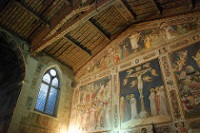
Santa Croce, a magnificent Gothic church built in 1294, contains the tombs of many celebrated Florentines, such as Michelangelo, Galileo, Ghiberti and Machiavelli. The Gothic interior is graced by the radiant frescoes of Giotto and his pupil Taddeo Gaddi, and integrated into the cloister next to the church is Brunelleschi's Pazzi Chapel (Cappella de' Pazzi). The tomb of famous composer Rossini is also a great favourite with visitors. When Lord Byron first laid eyes on the church he declared himself 'drunk with beauty'; a feeling shared by many visitors today. There is such a wealth of historic art and so many notable people buried at the church that tours are a great way to experience Santa Croce, but as it is a place of worship and they try to keep noise to a minimum headsets are compulsory for guided tour groups and must be requested at the Ticket Office by the tour leader. There are also detailed audio guides in English and other languages if you want to explore alone, but you will have to leave some form of identification at the desk when you collect one. The large square in front of the church is a great meeting place and there are some lovely restaurants and cafes about for refreshments.
Address : Piazza Santa Croce, 16
Website : www.santacroceopera.it/it/default.aspx
Telephone : +39 055 246 6105
Opening times : Open Monday to Saturday from 9.30am to 5.30pm, and on Sundays from 2pm to 5.30pm.
Admission : €8. Concessions are available
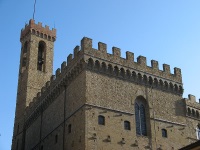
This Gothic Palazzo shelters a treasured national collection of Renaissance sculpture. Before its renovation to become Italy's first national museum, the building, constructed in 1255, functioned as a town hall, private residence and prison. It is one of the oldest buildings in Florence and has been the setting for some important episodes of civic history over the centuries, including sieges, fires and executions; the most famous being that of Baroncelli, who was executed for his involvement in a plot against the Medici, an execution witnessed by Leonardo da Vinci. An extensive collection of decorative art is on display, in addition to the magnificent sculptures of Michelangelo, Donatello, Giambologna and Cellini. The Palazzo's inner courtyard is ornamented with numerous coats of arms and the grand stairwell leading to the second-story loggia overflows with bronze birds created for the Medici's gardens. Other notable displays include an Islamic collection, an assortment of ivories (the largest collection in the world) and 16th-century majolica porcelain from Urbino, Faenza and Florence. The Bargello is one of the most famous and popular museums in Florence and seldom fails to impress and awe visitors.
Address : Via del Proconsolo 4
Website : www.beniculturali.it/mibac/export/MiBAC/sito-MiBAC/Luogo/MibacUnif/Enti/visualizza_asset.html_1634220952.html
Telephone : +39 055 238 8606. Reserve tickets on +39 055 294 883
Opening times : Open daily from 8:15am to 1:50pm. Closed on the first, third and fifth Monday of each month; closed on the second and fourth Sunday of each month; and closed on 1 January, 1 May and Christmas Day.
Admission : Ticket prices vary, concessions are available. Special exhibitions have an excess fee
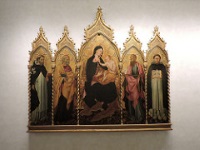
The Uffizi is one of the world's greatest art galleries, with a collection of Renaissance paintings that includes the works of Giotto, Masaccio, Paolo Ucello, Sandro Botticelli, Leonardo da Vinci, Michelangelo, Titian and Caravaggio. The collection is housed on the top floor of a building designed as the offices (uffizi) of the Medici, commissioned by Duke Cosimo I. From 1581, Cosimo's heirs used the upper storey to display the Medici art treasures. Ancient Greek and Roman sculptures line the inner corridors of the gallery and a series of rooms jut off from here, showcasing the chronological development of Florentine art from Gothic to High Renaissance and beyond. The scale and magnitude of the collection may need to be enjoyed over two visits. Rooms 1-15 (Florentine Renaissance) could be explored more thoroughly on the first trip and on the next visit one could concentrate on rooms 16 to 45 (from High Renaissance to later Italian and European paintings). The Uffizi is a must-see attraction in Florence if you have any interest in and appreciation for art, and many would argue that if you only visit one gallery in Italy this should be it. The queues can get frustratingly long so it is best to arrive as early as possible.
Address : Loggiato degli Uffizi 6
Website : www.beniculturali.it/mibac/export/MiBAC/sito-MiBAC/Luogo/MibacUnif/Enti/visualizza_asset.html_126669143.html
Telephone : +39 055 238 8651
Opening times : Open Tuesday to Sunday from 8.15am to 6.50pm. Closed on Mondays, 1 January, 1 May and 25 December.
Admission : Ticket prices vary, concessions are available. Special exhibitions have an excess fee

01474 814411

Travel Guide powered by Word Travels, copyright © 2023 Globe Media Ltd. By its very nature information in this travel guide is subject to change at short notice and travellers are urged to verify information on which they're relying with the relevant authorities. Neither Globe Media Ltd nor Travel Vogue can accept any responsibility for any loss or inconvenience to any person as a result of information contained above.